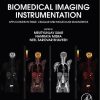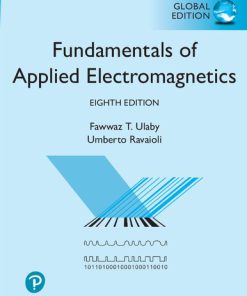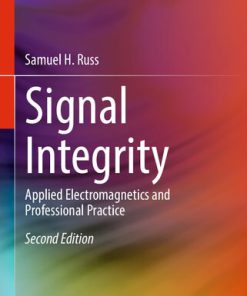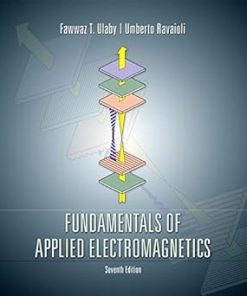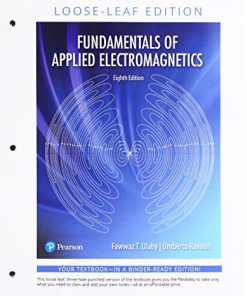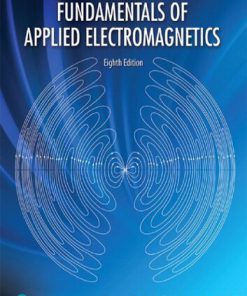Fundamentals of Applied Electromagnetics 8th Edition by Fawwaz Ulaby, Umberto Ravaioli 0136681581 9780136681588
$50.00 Original price was: $50.00.$25.00Current price is: $25.00.
Fundamentals of Applied Electromagnetics 8th Edition by Fawwaz Ulaby, Umberto Ravaioli – Ebook PDF Instant Download/Delivery: 0136681581, 9780136681588
Full download Fundamentals of Applied Electromagnetics 8th Edition after payment
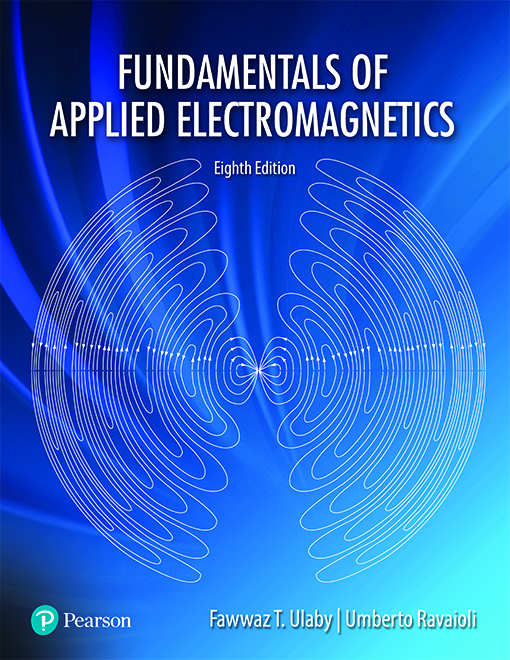
Product details:
ISBN 10: 0136681581
ISBN 13: 9780136681588
Author: Fawwaz T. Ulaby, Umberto Ravaioli
Pearson+ gives you access to much more than your eTextbook. Most titles also include audiobooks, study notes, flashcards and more to help you thrive in the classroom.
For courses in electromagnetics.
Bridging the gap between circuits and electromagnetics
Fundamentals of Applied Electromagnetics begins coverage with transmission lines, leading students from familiar concepts into more advanced topics and applications. Widely acclaimed, this authoritative text bridges the gap between circuits and electromagnetics material.
The 8th Edition builds on the core content and style of previous editions, retaining the student-friendly approach and hands-on simulation modules that help students develop a deeper understanding of electromagnetic concepts and applications. Enhanced graphs and illustrations, and an expanded scope of topics in the Technology Briefs, establish additional bridges between electromagnetic fundamentals and more.
Fundamentals of Applied Electromagnetics 8th Table of contents:
Chapter 1 Introduction: Waves and Phasors
Objectives
Overview
1-1 Historical Timeline
1-1.1 EM in the Classical Era
1-1.2 EM in the Modern Era
1-2 Dimensions, Units, and Notation
1-3 The Nature of Electromagnetism
1-3.1 The Gravitational Force: A Useful Analogue
1-3.2 Electric Fields
1-3.3 Magnetic Fields
1-3.4 Static and Dynamic Fields
1-4 Traveling Waves
1-4.1 Sinusoidal Waves in a Lossless Medium
1-4.2 Sinusoidal Waves in a Lossy Medium
1-5 The Electromagnetic Spectrum
1-6 Review of Complex Numbers
1-7 Review of Phasors
1-7.1 Solution Procedure
1-7.2 Traveling Waves in the Phasor Domain
Chapter 1 Summary
Concepts
Mathematical and Physical Models
Important Terms
Problems
Section 1-4: Traveling Waves
Section 1-5: Complex Numbers
Section 1-6: Phasors
Chapter 2 Transmission Lines
Objectives
2-1 General Considerations
2-1.1 The Role of Wavelength
2-1.2 Propagation Modes
2-2 Lumped-Element Model
Resistance R′
Inductance L′
Conductance G′
Capacitance C′
2-3 Transmission-Line Equations
2-4 Wave Propagation on a Transmission Line
2-4.1 Phasor-Domain Solution
2-4.2 Time-Domain Solution for υ(z, t)
2-4.3 Time-Domain Solution for i(z, t)
2-5 The Lossless Microstrip Line
2-5.1 Effective Permittivity
2-5.2 Characteristic Impedance
2-5.3 Design Process
2-6 The Lossless Transmission Line: General Considerations
2-6.1 Voltage Reflection Coefficient
2-6.2 Standing Waves
2-7 Wave Impedance of the Lossless Line
2-8 Special Cases of the Lossless Line
2-8.1 Short-Circuited Line
2-8.2 Open-Circuited Line
2-8.3 Application of Short-Circuit/Open-Circuit Technique
2-8.4 Lines of Length l = nλ/2
2-8.5 Quarter-Wavelength Transformer
2-8.6 Matched Transmission Line: ZL = Z0
2-9 Power Flow on a Lossless Transmission Line
2-9.1 Instantaneous Power
2-9.2 Time-Average Power
Time-Domain Approach
Phasor-Domain Approach
2-10 The Smith Chart
2-10.1 Parametric Equations
2-10.2 SWR Circle
2-10.3 Wave Impedance
2-10.4 SWR, Voltage Maxima, and Minima
2-10.5 Impedance to Admittance Transformations
2-11 Impedance Matching
2-11.1 Lumped-Element Matching
2-11.2 Single-Stub Matching
2-12 Transients on Transmission Lines
2-12.1 Transient Response to a Step Function
2-12.2 Bounce Diagrams
Chapter 2 Summary
Concepts
Mathematical and Physical Models
Important Terms
Problems
Sections 2-1 to 2-4: Transmission-Line Model
Section 2-5: Microstrip
Section 2-6: Lossless Line
Section 2-7: Wave and Input Impedance
Section 2-8: Special Cases of the Lossless Line
Section 2-9: Power Flow on Lossless Line
Section 2-10: Smith Chart
Section 2-11: Impedance Matching
Section 2-12: Transients on Transmission Lines
Chapter 3 Vector Analysis
Objectives
Overview
3-1 Basic Laws of Vector Algebra
3-1.1 Equality of Two Vectors
3-1.2 Vector Addition and Subtraction
3-1.3 Position and Distance Vectors
3-1.4 Vector Multiplication
Simple Product
Scalar or Dot Product
Vector or Cross Product
3-1.5 Scalar and Vector Triple Products
Scalar Triple Product
Vector Triple Product
3-2 Orthogonal Coordinate Systems
3-2.1 Cartesian Coordinates
3-2.2 Cylindrical Coordinates
3-2.3 Spherical Coordinates
3-3 Transformations between Coordinate Systems
3-3.1 Cartesian to Cylindrical Transformations
3-3.2 Cartesian to Spherical Transformations
3-3.3 Cylindrical to Spherical Transformations
3-3.4 Distance between Two Points
3-4 Gradient of a Scalar Field
3-4.1 Gradient Operator in Cylindrical and Spherical Coordinates
3-4.2 Properties of the Gradient Operator
3-5 Divergence of a Vector Field
3-6 Curl of a Vector Field
3-6.1 Vector Identities Involving the Curl
3-6.2 Stokes’s Theorem
3-7 Laplacian Operator
Chapter 3 Summary
Concepts
Mathematical and Physical Models
Important Terms
Problems
Section 3-1: Vector Algebra
Sections 3-2 and 3-3: Coordinate Systems
Sections 3-4 to 3-7: Gradient, Divergence, and Curl Operators
Chapter 4 Electrostatics
Objectives
4-1 Maxwell’s Equations
4-2 Charge and Current Distributions
4-2.1 Charge Densities
4-2.2 Current Density
4-3 Coulomb’s Law
4-3.1 Electric Field Due to Multiple Point Charges
4-3.2 Electric Field Due to a Charge Distribution
4-4 Gauss’s Law
4-5 Electric Scalar Potential
4-5.1 Electric Potential as a Function of Electric Field
4-5.2 Electric Potential Due to Point Charges
4-5.3 Electric Potential Due to Continuous Distributions
4-5.4 Electric Field as a Function of Electric Potential
4-5.5 Poisson’s Equation
4-6 Conductors
4-6.1 Drift Velocity
4-6.2 Resistance
4-6.3 Joule’s Law
4-7 Dielectrics
4-7.1 Polarization Field
4-7.2 Dielectric Breakdown
4-8 Electric Boundary Conditions
4-8.1 Dielectric-Conductor Boundary
4-8.2 Conductor–Conductor Boundary
4-9 Capacitance
4-10 Electrostatic Potential Energy
4-11 Image Method
Chapter 4 Summary
Concepts
Mathematical and Physical Models
Important Terms
Problems
Sections 4-2: Charge and Current Distributions
Section 4-3: Coulomb’s Law
Section 4-4: Gauss’s Law
Section 4-5: Electric Potential
Section 4-6: Conductors
Section 4-8: Boundary Conditions
Sections 4-9 and 4-10: Capacitance and Electrical Energy
Section 4-12: Image Method
Chapter 5 Magnetostatics
Objectives
Overview
5-1 Magnetic Forces and Torques
5-1.1 Magnetic Force on a Current-Carrying Conductor
5-1.2 Magnetic Torque on a Current-Carrying Loop
Magnetic Field in the Plane of the Loop
Magnetic Field Perpendicular to the Axis of a Rectangular Loop
5-2 The Biot–Savart Law
5-2.1 Magnetic Field Due to Surface and Volume Current Distributions
5-2.2 Magnetic Field of a Magnetic Dipole
5-2.3 Magnetic Force Between Two Parallel Conductors
5-3 Maxwell’s Magnetostatic Equations
5-3.1 Gauss’s Law for Magnetism
5-3.2 Ampeˋre’s Law
5-4 Vector Magnetic Potential
5-4.1 Vector Poisson’s Equation
5-4.2 Magnetic Flux
5-5 Magnetic Properties of Materials
5-5.1 Electron Orbital and Spin Magnetic Moments
5-5.2 Magnetic Permeability
5-5.3 Magnetic Hysteresis of Ferromagnetic Materials
5-6 Magnetic Boundary Conditions
5-7 Inductance
5-7.1 Magnetic Field in a Solenoid
5-7.2 Self-Inductance of a Solenoid
5-7.3 Self-Inductance of Other Conductors
5-7.4 Mutual Inductance
5-8 Magnetic Energy
Chapter 5 Summary
Concepts
Mathematical and Physical Models
Important Terms
Problems
Section 5-1: Magnetic Forces and Torques
Section 5-2: The Biot–Savart Law
Section 5-3: Maxwell’s Magnetostatic Equations
Section 5-4: Vector Magnetic Potential
Section 5-5: Magnetic Properties of Materials
Section 5-6: Magnetic Boundary Conditions
Sections 5-7 and 5-8: Inductance and Magnetic Energy
Chapter 6 Maxwell’s Equations for Time-Varying Fields
Objectives
Dynamic Fields
6-1 Faraday’s Law
6-2 Stationary Loop in a Time-Varying Magnetic Field
6-3 The Ideal Transformer
6-4 Moving Conductor in a Static Magnetic Field
6-5 The Electromagnetic Generator
6-6 Moving Conductor in a Time-Varying Magnetic Field
6-7 Displacement Current
6-8 Boundary Conditions for Electromagnetics
6-9 Charge–Current Continuity Relation
6-10 Free-Charge Dissipation in a Conductor
6-11 Electromagnetic Potentials
6-11.1 Retarded Potentials
6-11.2 Time-Harmonic Potentials
Chapter 6 Summary
Concepts
Mathematical and Physical Models
Important Terms
Problems
Sections 6-1 to 6-6: Faraday’s Law and its Applications
Section 6-7: Displacement Current
Sections 6-9 and 6-10: Continuity Equation and Charge Dissipation
Sections 6-11: Electromagnetic Potentials
Chapter 7 Plane-Wave Propagation
Objectives
Unbounded EM Waves
7-1 Time-Harmonic Fields
7-1.1 Complex Permittivity
7-1.2 Wave Equations
7-2 Plane-Wave Propagation in Lossless Media
7-2.1 Uniform Plane Waves
7-2.2 General Relation between E and H
Wave Propagating Along +z with E Along x^
Wave Propagating Along −z with E Along xˆ
Wave Propagating Along +z with E Along xˆ and yˆ
7-3 Wave Polarization
7-3.1 Linear Polarization
7-3.2 Circular Polarization
Left-Hand Circular (LHC) Polarization
Right-Hand Circular (RHC) Polarization
7-3.3 Elliptical Polarization
7-4 Plane-Wave Propagation in Lossy Media
7-4.1 Low-Loss Dielectric
7-4.2 Good Conductor
7-5 Current Flow in a Good Conductor
7-6 Electromagnetic Power Density
7-6.1 Plane Wave in a Lossless Medium
7-6.2 Plane Wave in a Lossy Medium
7-6.3 Decibel Scale for Power Ratios
Chapter 7 Summary
Concepts
Mathematical and Physical Models
Important Terms
Problems
Section 7-2: Propagation in Lossless Media
Section 7-3: Wave Polarization
Sections 7-4: Propagation in a Lossy Medium
Section 7-5: Current Flow in Conductors
Section 7-6: EM Power Density
Chapter 8 Wave Reflection and Transmission
Objectives
EM Waves at Boundaries
8-1 Wave Reflection and Transmission at Normal Incidence
8-1.1 Boundary between Lossless Media
8-1.2 Transmission-Line Analogue
8-1.3 Power Flow in Lossless Media
8-1.4 Boundary between Lossy Media
8-2 Snell’s Laws
8-3 Fiber Optics
8-3.1 Maximum Acceptance Cone
8-3.2 Confined Acceptance Cone
8-4 Wave Reflection and Transmission at Oblique Incidence
8-4.1 Perpendicular Polarization
8-4.2 Parallel Polarization
8-4.3 Brewster Angle
Perpendicular Polarization
Parallel Polarization
8-5 Reflectivity and Transmissivity
8-6 Waveguides
8-7 General Relations for E and H
8-8 TM Modes in Rectangular Waveguide
8-9 TE Modes in Rectangular Waveguide
8-10 Propagation Velocities
8-11 Cavity Resonators
8-11.1 Resonant Frequency
8-11.2 Quality Factor
Chapter 8 Summary
Concepts
Important Terms
Mathematical and Physical Models
Problems
Section 8-1: Reflection and Transmission at Normal Incidence
Sections 8-2 and 8-3: Snell’s Laws and Fiber Optics
Sections 8-4 and 8-5: Reflection and Transmission at Oblique Incidence
Sections 8-6 to 8-11: Waveguides and Resonators
Chapter 9 Radiation and Antennas
Objectives
Overview
Reciprocity
Radiation Sources
Far-Field Region
Antenna Arrays
9-1 The Hertzian Dipole
9-1.1 Far-Field Approximation
9-1.2 Power Density
9-2 Antenna Radiation Characteristics
9-2.1 Antenna Pattern
9-2.2 Beam Dimensions
9-2.3 Antenna Directivity
9-2.4 Antenna Gain
9-2.5 Radiation Resistance
9-3 Half-Wave Dipole Antenna
9-3.1 Directivity of λ/2 Dipole
9-3.2 Radiation Resistance of λ/2 Dipole
9-3.3 Quarter-Wave Monopole Antenna
9-4 Dipole of Arbitrary Length
9-5 Effective Area of a Receiving Antenna
9-6 Friis Transmission Formula
9-7 Radiation by Large-Aperture Antennas
9-8 Rectangular Aperture with Uniform Aperture Distribution
9-8.1 Beamwidth
9-8.2 Directivity and Effective Area
9-9 Antenna Arrays
9-10 N-Element Array with Uniform Phase Distribution
9-11 Electronic Scanning of Arrays
9-11.1 Uniform-Amplitude Excitation
9-11.2 Array Feeding
Chapter 9 Summary
Concepts
Mathematical and Physical Models
Important Terms
Problems
Sections 9-1 and 9-2: Short Dipole and Antenna Radiation Characteristics
Sections 9-3 and 9-4: Dipole Antennas
Sections 9-5 and 9-6: Effective Area and Friis Formula
Sections 9-7 and 9-8: Radiation by Apertures
Sections 9-9 and 9-11: Antenna Arrays
Chapter 10 Satellite Communication Systems and Radar Sensors
Objectives
Application Examples
10-1 Satellite Communication Systems
10-2 Satellite Transponders
10-3 Communication-Link Power Budget
10-4 Antenna Beams
10-5 Radar Sensors
10-5.1 Basic Operation of a Radar System
10-5.2 Unambiguous Range
10-5.3 Range and Angular Resolutions
10-6 Target Detection
10-7 Doppler Radar
10-8 Monopulse Radar
People also search for Fundamentals of Applied Electromagnetics 8th:
fundamentals-of-applied-electromagnetics-8th edition solution manual
fundamentals of applied electromagnetics solutions
what are the four fundamental forces in physics
5 fundamental forces of physics
Tags:
Fawwaz Ulaby,Umberto Ravaioli,Fundamentals,Electromagnetics
You may also like…
Physics - Electricity and Magnetism
Fundamentals of Applied Electromagnetics, Global Edition, 8th Edition Fawwaz Ulaby
Engineering - Telecommunications
Signal Integrity: Applied Electromagnetics and Professional Practice 2nd Edition Samuel H. Russ
Science Fiction - Fantasy Fiction
Engineering - Electrical & Electronic Engineering
Fundamentals of Applied Electromagnetics 1st Edition by Fawwaz, Umberto 9780133356816 0133356817
Physics - Electricity and Magnetism
Fundamentals of Applied Electromagnetics (8th Edition) Fawwaz T. Ulaby
Physics - Electricity and Magnetism
Fundamentals of Applied Electromagnetics (8th_Edition) Fawwaz T. Ulaby
Medicine - Medicine & Nursing Reference
Kozier and Erb’s Fundamentals of Nursing 11th Edition by Audrey T. Berman 9780135428757 0135428750
Engineering - Automotive
Fundamentals of Automotive Technology Third Edition. Edition Kirk T. Vangelder

